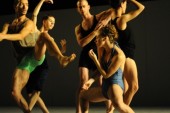
Dancemakers – The Adaptation Project – Ömer K. Yükseker
Everything has been done already, in some form or another. In the words of Goethe, “Everything has been thought of before, but the problem is to think of it again”. On this point, Goethe and Michael Trent, artistic director of Dancemakers Centre for Creation and choreographer of Adaptation Project, firmly agree. Delving into Toronto dance history and the Dancemakers video archives, Trent created Adaptation Project in response to Mitchel Rose’s 1974 choreography, Following Station Identification. In Adaptation Project, Trent uses Rose’s choreography, and the adaptation process itself as the inspiration for his creation.
The impetus for Adaptation Project came from Trent ‘s desire to create a piece of choreography that would connect and respond to the company’s 38 years of dance, including a repertoire of over one hundred Canadian and International choreographies.
Adaptation Project begins casually. Five dancers mill about the stage in warm-up gear, hoodies and track pants, as musician Thom Gill sets up in the corner fiddling with instruments and sound equipment.
Throughout the performance, offstage is onstage. Along the edges of the space, the dancers seemingly relax, peel off layers, sit down, and watch each other, adding to the casual and personal feel of the show. It looks as though the audience just happened upon a rehearsal, and like a rehearsal, the show has that intimate, messy, and spontaneous, anything-can-happen feeling about it.
Throughout Adaptation Project, the dancers shift in and out of each other’s spaces, coupling briefly and dissolving, continuously reestablishing their relationships. At one point, Kate Holden and Robert Abudo begin a diagonal duet. Holden’s head presses into Abudo’s back, as they move slowly like molasses, silently supporting each other’s weight. Suddenly, she hangs from him, floating as if in an alternate universe, upside down, limbs suspended; all set to Christopher Willes’ eerie and atmospheric score performed live onstage by Thom Gill.
Throughout Adaptation Project, each performer leaves a piece of themselves in Trent’s choreography, a residue of movement which is both personal and palpable.
Arms up and outstretched as though towards an oracle, Kamino stands transfixed as he, and Holden, begin an intimate exchange of thoughts through movement. Grabbing wildly at the air in front of him like a small child catching butterflies, she holds him, her arms wrapped firmly around his chest. Slowly, their roles shift and he clutches her as she leaps backwards, arching towards him, her arms flailing frantically, her eyes closed. Kamino’s presence onstage is striking, and together he and Holden construct a precise and delicate emotional world.
The coherence of Adaptation Project is not in the movement vocabulary, form, or structure but in the feeling. Trent builds a surprising, yet weighted world of sensation, filled with tenderness, confusion, poignancy and connection. Adaptation Project is a thoughtful and intimate a series of unfinished conversations, a re-crafting of movement belonging to other bodies from another time.
This is dance for dancers, which, for better or for worse, has as its primary reference – itself.
At one point, the three male dancers writhe in a pile in the corner, their bodies rolling over each other as they cross the stage struggling to peel off each other’s clothes as they tumble. By the end, they are panting, exhausted, and stripped down to nothing but black boxer briefs and knee-pads.
The Adaptation Project closes with the dancers laid out on floor, watching a back wall projection of the original footage from Rose’s 1974 choreography.
In this moment, the gritty low-resolution archival footage acts as a time capsule, contextualizing what the audience has just seen, the spark from which Adaptation Project was born.
Through this interpretation, Trent picks up the thread and continues a years-long conversation. In a world where everyone is striving to create the newest, boldest, and most original work, perhaps, as Trent suggests, there is a value in looking backwards, turning inward, and re-engineering the past to inform the present in a conscious and meaningful way.
_____
Adaptation Project
Dancemakers
April 19-29, 8pm
Dancemakers Centre for Creation
55Mill Steet, Building 74
For tickets call: 416 367-1800 or visit: www.dancemakers.org
_____
For more, follow us on Twitter at @torontostandard, and subscribe to our newsletter.














